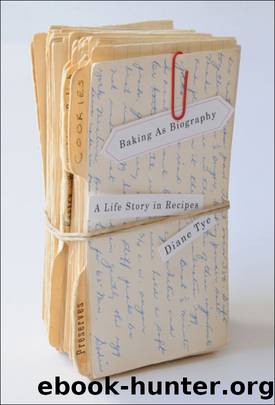Baking as Biography by Diane Tye

Author:Diane Tye [Diane Tye]
Language: eng
Format: epub
Publisher: MQUP
Published: 2010-12-15T00:00:00+00:00
LADIESâ TEAS
The foods, as well as the organizing principles of specialization and variety, that governed lunches reached their peak when the church women organized other food events such as wedding or funeral receptions, major fund-raisers such as church suppers, or ladiesâ teas.13 Jean Colborneâs letters through 1949 and 1950 demonstrate that lunches were part of a larger network of food events that included weddings, showers, and other church or community functions. For example, Colborne describes a wedding reception where fifty people sat down to âa huge supper of chicken and ham and salads and dessert, and at our table alone there were ten different kinds of cakesâ (2003, 93). Likewise, Anne Green describes an elaborate selection of foods and speaks appreciatively of individual womenâs specialities in talking about the soup and dessert luncheons her church group currently hosts: âWe have soup and dessert luncheons ... this is a money raiser. And we have all kinds of desserts. We have maybe two kinds of soup. Well, I have a list of people to phone and what to get from them. And I usually make a rhubarb torte ... And people wait for that rhubarb torte. You wouldnât believe. By the end of it, itâs goneâ (Green, Interview, 2004).
The most formal of all church food events was the tea. At teas, the principles of variety and quality reached a pinnacle at the same time as they were coupled with higher standards for presentation than lunches, fund-raising luncheons or suppers, which could run the gamut from casual, stand-up, self-service meals to sit-down dinners at waited tables. That said, the food served may not have differed markedly from that featured at the other food events just described. For example, one 1940s etiquette book my mother owned stipulates that the food at an informal or casual tea âshould be quite simple â dainty sandwiches and cakes served with tea, coffee, or chocolateâ (Eichler 1940, 215). At a formal tea, â[t]he food served should not be so substantial that it interferes with dinner. A typical menu might consist of a light salad, hot rolls or muffins, tea or coffee, and cookies. Neither dessert or rich cakes should be served at a teaâ (Eichler 1940, 216).
However, what separated the ladiesâ tea from other events was not so much its food as its formality. Teas offered women the opportunity to focus on elements such as presentation and etiquette. Paper plates or Styrofoam cups might have been acceptable for an after-church lunch, but the formality of a ladiesâ tea required white tablecloths and china cups.
Download
This site does not store any files on its server. We only index and link to content provided by other sites. Please contact the content providers to delete copyright contents if any and email us, we'll remove relevant links or contents immediately.
Hit Refresh by Satya Nadella(8854)
When Breath Becomes Air by Paul Kalanithi(8038)
The Girl Without a Voice by Casey Watson(7602)
A Court of Wings and Ruin by Sarah J. Maas(7252)
Do No Harm Stories of Life, Death and Brain Surgery by Henry Marsh(6683)
Shoe Dog by Phil Knight(4885)
Hunger by Roxane Gay(4677)
A Higher Loyalty: Truth, Lies, and Leadership by James Comey(4550)
The Rules Do Not Apply by Ariel Levy(4523)
Everything Happens for a Reason by Kate Bowler(4474)
Tuesdays with Morrie by Mitch Albom(4395)
The Immortal Life of Henrietta Lacks by Rebecca Skloot(4253)
How to Change Your Mind by Michael Pollan(4112)
Millionaire: The Philanderer, Gambler, and Duelist Who Invented Modern Finance by Janet Gleeson(4093)
All Creatures Great and Small by James Herriot(3986)
Tokyo Vice: An American Reporter on the Police Beat in Japan by Jake Adelstein(3860)
Elon Musk by Ashlee Vance(3854)
The Money Culture by Michael Lewis(3846)
Man and His Symbols by Carl Gustav Jung(3845)
